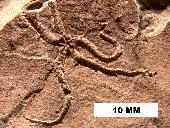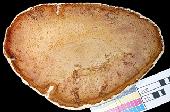|
 See More Images See More Images

Thalassodendron
© 2004 Roger Portell, Florida Museum of Natural History

Palmoxylon
© 2003 Scott Singleton, Louisiana Geological Society

Sabalites sp.
© 2002 The Virtual Fossil Museum
|
What are Monocots? Monocots comprise nearly one fourth of all the living flowering plants, including many economically important ones like rice, corn, wheat, sugar cane, bananas, and bamboo. They get their name from having one cotyledon, or “seed leaf,” which transports nutrients from the seed to the developing embryo. Monocots are most easily recognized by the parallel veins in their leaves. They are primarily tropical plants, although grasses and many others grow in temperate and even polar regions. The fossil record of monocots is patchy and known mainly from pollen, but it extends at least into the Late Cretaceous. First known fossil occurrence: Cretaceous. Last known fossil occurrence: Quaternary. This group has living relatives. |
Fossils through time:
Choose a time period to see what life was like:
|
|